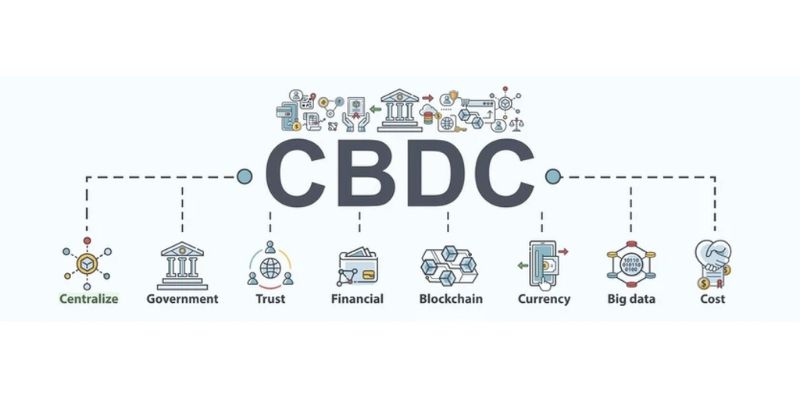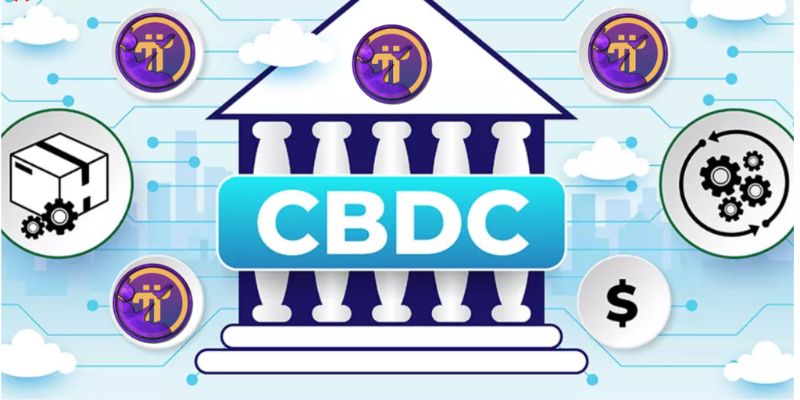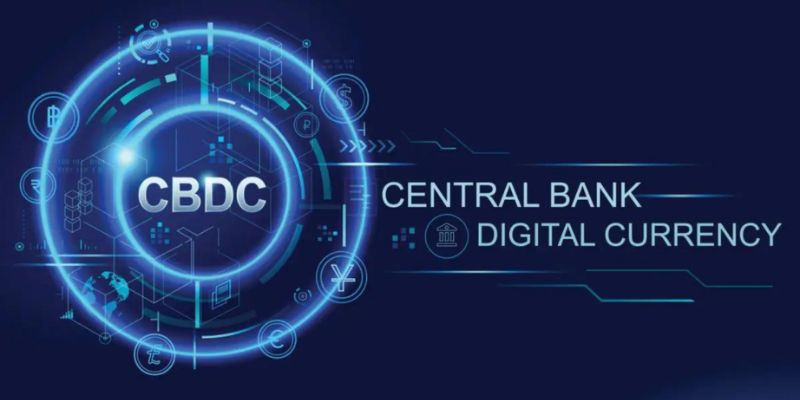Impact of CBDC: Will It Revolutionize Traditional Banking?
Banks as we know them could face a huge shake-up soon. We’re zooming in on the impact of CBDC on traditional banking, and let me tell you, it’s more than just a tweak here and there. Picture this: digital money, backed by the country’s central bank, that you can use just like the cash in your pocket. Sounds convenient, right? But it’s not that simple. Banks have ruled the finance world for a long time, and this digital twist could rewrite the entire playbook. In this deep dive, we’ll unpack what the shift to this newfangled currency means for your everyday banks. Get ready, because it’s not just about paying with your phone—it’s about a money makeover that might just turn banking upside down.
Understanding CBDC Implementation and its Consequences for Banking
Anticipating Changes to the Banking Sector Landscape
You might wonder, what’s the buzz about CBDCs? CBDC stands for Central Bank Digital Currency. It’s a digital form of money, like the cash in your wallet, but on your phone or computer. Banks are thinking hard about CBDCs, and for good reason. They could change how we all handle money every day.
Let’s break it down a bit. Today, when you put money in a bank, it stays there until you take it out. Simple, right? With CBDCs, money could zip around faster between banks. That means banks might need new ways to keep track of it all.
Now, how might this change your trip to the bank or ATM? If you use CBDCs, you might not need to go as often. You can pay for things quick and easy with a tap on your phone. Also, banks could come up with new services thanks to CBDCs. That’s something to look forward to.
But it’s not all smooth sailing. Banks have to be sure they can handle CBDCs without hiccups. They also need rules to make sure everyone’s money is safe. This can be tricky, but it’s super important. We all want our money to be safe and sound, right?
Evaluating Central Bank Digital Currencies and Their Effects
So, will CBDCs and banks get along? Think of it like making a new friend. They have a lot to learn about each other. For banks, they’ll have to change some ways they do their job. They’ll also have to make sure they can work with CBDCs without any mix-ups.
CBDCs might be faster than the way banks move money now. People could like that a lot. Banks might need to speed up, too. If they don’t, folks might choose CBDCs instead. This could make banks step up their game.
How about bank workers? They might need to learn new skills. They’ll want to know all about how CBDCs work. That way, they can help you and me when we have questions.
Another big question is about how safe CBDCs are. Banks will play a big part in answering this. They will work with folks who make laws to keep our money safe with CBDCs. It’s a big job, but someone’s got to do it.
And what about credit—like loans for homes or businesses? Banks often use the money we deposit to give out loans. If we all use CBDCs, banks will have to think of new ways to lend money. It’s a puzzle, but I bet they’ll find a solution.
In the end, CBDCs have a lot to offer, but they come with homework for banks. It’s like going to a new school and learning the ropes. Banks will have to adapt to stay top-notch. With everyone on board, CBDCs could make handling money easier and cooler for us all.

Operational Impacts and Challenges Presented by CBDCs
CBDC vs Traditional Banking: Operational Considerations
CBDCs are shaking things up for traditional banks. They mean big changes in how money moves. These digital bucks are like cash but online. Banks now have to think differently about the ways they do things. They work to fit CBDCs into their day-to-day. Guess what? This can mean better and faster ways for people to pay each other.
Banks need to be quick on their feet to keep up. CBDCs can zoom around fast, and banks want to be part of that race. They’re working hard to make sure they can handle these speedy digital dollars.
But it’s more than just speed. CBDCs could change where you keep your money. They could touch everything from your savings account to the way you get loans. Let’s not forget they might make paying someone in another country as easy as sending a text.
The world of banking is on the edge of big change. And it’s CBDCs pushing it forward.
Addressing Potential Digital Currency Challenges for Banks
Let’s dive into the deep end. Banks face some real head-scratchers with CBDCs. Top of the list? How to keep your money safe. With digital dollars, privacy is big. Banks need to be ninjas, keeping your cash and details under wraps.
They also must ask: “How can we make money when people use CBDCs?” Banks need to stay smart to keep bringing in the dough.
Another puzzle is all about teamwork. Banks and CBDCs must work together like peanut butter and jelly. This means banks must speak the same digital language as CBDCs.
Banks are like jugglers, keeping all these balls in the air. They’re thinking smart about how to face these challenges without dropping the ball.
Whew! That’s a lot for banks to chew on. But guess what? They’re stepping up. And that means we might all look at our bank accounts a bit differently in the future.

Regulatory Reforms and CBDC Integration into Current Systems
Balancing Innovation with Privacy in the Age of Digital Currency
Picture a world where money moves like messages. No heavy purses or waiting for bank transfers. That’s what a Central Bank Digital Currency (CBDC) can do. Yet, banks face the big job of keeping personal details safe while offering new, fast services.
CBDC makes things quicker but also brings privacy worries. Banks now have to protect client info more than ever. They must find a middle ground. It’s like putting up a fence that keeps the bad guys out but lets the good stuff in and out with ease.
Working on this, banks look at rules that guide this new money world and change them as needed. They learn from the internet and how it secures data. They take the best parts and use them to shield our money talks.
We’re talking about not just secrets but how we use money daily. If a friend sends you digital cash for lunch, you don’t want the whole world to know, right? Banks get this. They are working hard to make sure that they can keep these secrets even when they move to digital money.
Ensuring Interoperability Between CBDC Platforms and Existing Banking Infrastructures
Now, think of CBDCs and banks as two dance partners. They need to move together without stepping on each other’s toes. Banks are used to their own way of moving. CBDC comes in with a new rhythm.
To dance smoothly, they both need to speak the same language. That’s what interoperability means. Banks must make sure their systems can talk to the new CBDC platforms, and there’s a lot of work to do.
They have to handle two types of money: cash and CBDC. And they need to make it all feel the same to us, the users. Just like we don’t think about how an ATM works, we shouldn’t have to worry about the tech behind CBDCs. It should just work.
And while banks are figuring this out, they keep an eye on how fast CBDCs should move money around. They want to have it just right. Not too slow, so we’re not waiting. Not too fast, so they can ensure everything is safe and right.
Banks are talking with governments to make sure they get these steps right. They’re looking at how other countries are doing it and learning from them. After all, no one wants to make a money mistake.
So, as we step into this future of digital money, banks are thinking hard about two big things. How do they keep our money chats under wraps? And how do they get their old systems to buddy up with the new kid, CBDC? They want to make the move without missing a beat, and they’re working tirelessly to choreograph this financial dance beautifully.

The Future of Banking: Adapting to Fiscal and Monetary Implications of CBDCs
The Role of CBDC in Reshaping Bank Revenue and Credit Creation
CBDCs are fresh winds in bank sails. They may change how banks make money. CBDC means ‘central bank digital currency’. It’s a digital cash form from a country’s bank. It works like the paper money in your pocket. But, it’s on screens, not in hands.
Think of a game arcade. You trade cash for tokens to play games. CBDC is like that. You trade your paper dollars for digital tokens. These come from the central bank. They are safe and official money.
Banks give loans, creating credit. This is how they earn. CBDCs could change this game. If we all use CBDC, banks might have to find new ways to earn. This could mean less money for banks. People might save more CBDC than they borrow. They could use CBDC for daily buy and sell, not bank loans. This means banks would have to think of new things. New services or ways to attract money and give loans. Maybe they charge for unique help or give better interest.
CBDCs might also speed up payments between countries. This is because digital things often move faster than paper or coins. This could be good for businesses. They would not have to wait long for money to come or go. But banks might lose fees they get from slow old ways. Banks need to get ready for this.
Banks must be clever. They have to adapt and grow. Their future depends on it. With CBDC, they might offer things that CBDC does not. Like personal advice or special services. They will play a big role in our digital money future.
Assessing the Impact of CBDC on Financial Stability and Intermediation
Now, let’s talk about financial balance. This is about money staying safe and steady. When big change comes, like CBDC, we must be careful. It can shake up finance a lot. If everyone moves to CBDC all at once, it could unsettle things. Banks are in the middle of money matters. They take from savers and give to borrowers. This is called ‘financial intermediation’.
CBDC could make some waves here. If people keep more digital currency, they might not put as much in banks. This can make it tricky for banks to lend. They need the deposits to make loans. Fewer loans could mean businesses struggle to grow. This could slow down the economy.
But, CBDC could also help. It could make payments safer and less costly. This could mean more trust in money systems. With smart rules, CBDC can fit in just right. It could work well with banks. Banks stand strong when they handle change right.
Banks and governments will work together. They’ll make sure CBDC benefits all. It should not harm our money system or people’s trust.
Innovation is great. It moves us forward. But it must be done with care. This is how we keep finance strong. It’s how we build a good future. For banks and for us all.
In this post, we dug deep into how digital currency will shake up banking. We looked at how banks will change, how digital cash might upset things, and how rules need to bend for a new money world. These coins from central banks will flip how we think about our cash. Banks must think fast to stay in the game. They’ll face tough tech troubles and will have to play nice with the way cash works now. Everyone’s trying to guess how this will affect money and loans. Here’s what’s clear: the future of banks hangs on them getting this digital cash thing right. They’ve got to balance tech smarts with keeping our money safe. We’re stepping into a world where our wallets get a huge tech boost. It’s exciting and a bit scary, but we’ll all be a part of it. Let’s get ready for the ride and help shape how our money moves next.
Q&A :
How Will CBDCs Affect Traditional Banks?
Central Bank Digital Currencies (CBDCs) could have profound effects on traditional banking by introducing a digitized, secure form of legal tender directly from central banks. Traditional banks may need to adapt their services to accommodate the efficiencies and the potentially lower costs of CBDC transactions. CBDCs could lead to a more direct relationship between central banks and consumers, possibly bypassing some functions of commercial banks.
Can CBDCs Replace Physical Cash And The Need For Commercial Banks?
CBDCs are not likely to completely replace physical cash in the near future due to the digital divide and the varying preferences of users; however, they might significantly reduce the necessity for cash. As for replacing commercial banks, CBDCs could take over some functions such as the issuance of money and transaction settlements but are unlikely to render the diverse range of services provided by commercial banks obsolete.
What Are The Potential Risks Of CBDCs To The Traditional Banking Industry?
Introduction of CBDCs could lead to disintermediation, with some consumers possibly preferring to hold their funds as central bank money rather than deposits at commercial banks. This could reduce the deposit base and the lending capacity of traditional banks. Moreover, CBDCs might intensify competition and lead to changes in the interest rates offered by banks to retain customers.
How Might Traditional Banks Compete With The Convenience Of CBDCs?
In order to compete with the ease and potentially lower costs of CBDC transactions, traditional banks might focus on improving personalized customer services, offering competitive interest rates, and creating innovative financial products. Additionally, they could invest in advanced technology to enhance their digital banking services and partner with fintech companies to maintain their relevance and appeal to customers.
Will CBDCs Lead To Greater Financial Inclusion?
CBDCs have the potential to enhance financial inclusion by providing a digital payment option that is accessible to all segments of the population, including those without traditional bank accounts. However, achieving greater financial inclusion will depend on factors such as public awareness, digital literacy, and the availability of affordable internet access and technology to utilize digital currencies.

